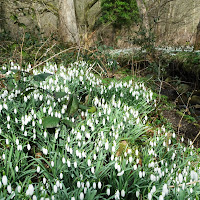Today - before preparing the Sunday roast dinner - I drove out of the city to Shotts Lane. It is a cul-de-sac where I have often parked Clint and previous vehicles too - Keith, Dave the Ford Focus, Pierre and Graham the Seat Ibiza. With boots on, I set off marching my very familiar circular route. If I don't loiter or stop to take photographs, the walk takes me exactly an hour.
This morning I was slowed down by the snowdrops that gather on the banks of Redcar Brook. Such a beautiful display this year. Thousands of them. I paused to take pictures as I acknowledged their loveliness. They were so lovely that tomorrow I plan to add a poem called "Snowdrops" to this blogpost.
Googling "snowdrops", I discovered that they are not in fact native plants. They were introduced long ago - possibly during the era of Roman occupation but were certainly well-established by the sixteenth century. Interestingly, William Shakespeare never referred to snowdrops in his writings though he did remark upon daffodils in "The Winter's Tale": "When daffodils begin to peer, - With hey! The doxy over the dale, - Why, then comes in the sweet o' the year".
from Yorkshire Pudding https://ift.tt/IbEYjFx




